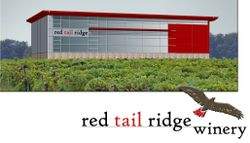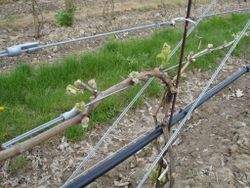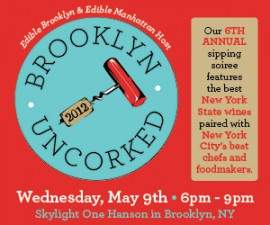Red Tail Ridge Winery: A Different Kind of Investment
By Jason Feulner, Finger Lakes Correspondent

While the basic strategy for opening a functional winery differs from region to region, in the Finger Lakes the trend seems to follow a path that calls for the opening of the tasting room first with production facility and vineyard coming later.
While this might be a generalization of sorts, it makes sense in many respects. Nearly 75% of wine sales in the Finger Lakes occur on site; many larger wineries lease production space; and a vineyard takes quite a few years to produce grapes.
A winemaker or entrepreneur can purchase grapes, make wine at a different facility, and then sell it in a tasting room to raise capital for the eventual construction of the production facility and vineyard. I can think of several newer Finger Lakes wineries that have gone this route. Most importantly, the tasting rooms are placed prominently next to main roads so that wandering tourists will stop inside and spend their money.
Not so at Red Tail Ridge. When I visited this new winery last summer on the western shore of Seneca Lake, the progression of the operation struck me as unique. The well-marked entrance from Route 14 invites visitors up a long, winding dirt road, but there is no sign of a tasting room at all. In fact, all one can see up and over the rolling hill are acres and acres of vines.
These are impressive rows of young vines, well spaced and groomed with thick trellises anchored so securely that it looks like a raging tornado would leave the plants intact.

As the dirt road deposits you in the midst of this 30-plus acre vineyard, it's difficult not to be surprised by the small, temporary-looking building that serves as the tasting room. The building looks so out-of-place in the middle of the vast vineyard because it is indeed temporary. Red Tail's owner and winemaker, Nancy Irelan, has bigger and better plans for the facility. She and her co-owner and husband Michael Schnelle want to try something a little different.
A 15-year veteran of the California wine industry and a Ph.D.-holding geneticist specializing in oenology, Nancy Irelan did not invest first in her vineyard based on a whim. She believes that wines are made in the vineyard, and while this may be the ultimate winemaking cliché, Irelan is very specific about what she means.
To find the fruit and aroma characteristics she is looking for, Irelan created the vineyard to be something akin to an experimental station, with several varieties under examination to gauge their promise in the region's cool growing climate. One such experiment is Teroldego, a rare red grape from northern Italy.
Irelan has planted many different clones of more popular varieties to see how to best find the flavor profiles she desires. The many rows of pinor noir are made up of several different clones, as Irelan feels that the right mixture of these clones might unlock the key to a wine that shows a lot of potential in the Finger Lakes at times, but in many instances falls a little flat.
The vineyard appears well-designed aesthetically, and this impression is not superficial. If prompted, Irelan can explain in detail all the decisions that were made concerning drainage (the property is extensively tiled), moisture control, erosion control, row spacing, etc. She emphasizes that the methodical nature of the design plan creates a sustainable vineyard that has a minimal environmental impact.
In this spirit, Red Tail Ridge has retained Edge Architecture PLLC to design a tasting room and production facility that carries the ultimate seal of environmental sustainability, LEED-platinum certification (Learn more about LEED certification). If built to the specification of its current conception (see the graphic at the top of this post), the Red Tail Ridge winery will be the only LEED-certified facility in the heart of the Finger Lakes and one of only a handful of environmentally advanced buildings in all of upstate New York.
Nancy Irelan and Michael Schnelle hope to break ground on the foundation of the new facility this spring.
So, does what does a unique building like this have to do with making good wine? Well, everything and nothing, as Irelan explains: "No, it will not have an effect on the wine, but that’s not why we are doing this. This may be 'just a building' to most folks, but it's probably the only winery that Michael and I will ever build, so it needs to be representative of us and our values. Sustainability is a part of our mind set and something that we believe in."
Admittedly, Irelan came to the Finger Lakes with an extensive capital plan (she originally assumed she would be investing in California's expensive industry) but she has taken the opportunity to use the region's flexible market to enhance her business. I have yet to taste samples of Red Tail Ridge's newest vintage, but I am excited about the dedication the owners are making to the region as well as the spirit they exhibit in creating a unique sense of place.
Red Tail Ridge as a destination will be something to behold, and that's never a bad thing.













I wrote a winemaker profile of Nancy Irelan for Life in the Finger Lakes this past year. The article, minus the lovely photos (unfortunately) has been reproduced at this link:
http://www.lifeinthefingerlakes.com/articles.php?view=article&id=440
Jason: Red Tail Ridge actually has a link to a PDF of the story, which includes the pictures (and ads of course):
http://www.redtailridgewinery.com/rtr_directory.taf?_function=record&dr_id=19&dr_cat=4
The wines from RTR have been consistently clean and enjoyable, especially for young vines. I know that Nancy has benefited from the help provided by Peter Bell at Fox Run, and the results are impressive. Mike is, by all appearances, a talented grower — and that’s more important than perhaps anything else. What the Finger Lakes desperately needs is improvement in growing practices.
good post, sound like a place to see indeed. I am all about the experimentation in variety selection. Here in the Hudson Valley, Stoutridge has planted some Teroldego, Sangiovese, and Refosco, they should be fruiting this season or next.
I wanted to add a P.S. here after looking at the picture of the winery building. For one, it kind of looks like one of those self-storage places. And two, anybody researching sustainable long lasting buildings should know there is a hard and fast rule in architecture; FLAT ROOFS ALWAYS LEAK. Given time, there are no exceptions. They should check out “The Long Now” foundation.
Rowland, I appreciate the comments but I must emphasize that the picture you see was lifted from a larger mock-up that had all kinds of features highlighted from various angles with floor plans, etc.
So, your point might be valid but I don’t tink we can know how it would apply in this particular case. The original image here was a very small feature on the mock-up and it shows how the building would appear from near the road, a lower elevation which would obscure the true overall shape of the building.
Teroldego: great choice. It’s home is in the Adige, a cool growing region.
It’s a vigorous and prolific vine, and loves good drainage. It’s an aromatic, to be sure and low in tannin while good with extract and color.
Recent research shows the grape is genetically related to Syrah, Marzemino and Lagrein, the latter being among my favorite north climate reds.
I often wonder why Finger Lakes producers spend their time with Bordeuax varieties when they can probably do well with northern Italian varieties, provided they can give the vines decent southern exposure.
I have my eye on a spot on the Keuka Lake’s Bluff Point that looks ideal for Nebbiolo!
Thomas,
Have you tasted many 2007 Finger Lakes red yet? How about 2005? I’d say you’ll have your answers as to why Finger Lakes producers spend their time with Bordeaux varieties.
That said, I’ve often wondered how many local winemakers (Cornell, perhaps?) have studied other wine regions with closer topographical and climatological profiles. Heck, if you’re looking for vinifera outside the mainstream, Jim Hazlitt has probably grown it! But I’m certainly curious to see what else has potential here.
Evan,
I should have been more clear: building a Bordeaux variety red wine business in the FLakes requires a lot of prayer that a winter zap won’t kill them and that at least two out of every eight vintages will be stellar.
I know the answer to my question has to do with marketing the varietal wine ‘names’ but I think these days, with many reds like the Alto Adige and Piemonte varieties, it’s worth doing what Nancy Irelan is doing.
You are right about Jim Hazlitt, though. One of the best growers around. Where the hell is his single vineyard wine?
Knapp Vineyards once grew Nebbiolo. Don’t know what happened, though.
Thomas,
Given your impressive background and knowledge about how varietals grow in the Finger Lakes, I’m curious to know how you would rank the “non-traditional” varietals in terms of their potential here.
Evan,
If you mean the varieties I mentioned, I have no idea. It would take trials, as Nancy Irelan is doing.
The Knapp Nebbiolo I mentioned didn’t seem to work out.
Since much of Finger Lakes vineyards are planted with east/west exposure, it could be problematic for those varieties. In their cool mountain regions they generally have direct southern exposure-and that could be what makes all the difference-it’s amazing to see the nebbiolo vineyards of Valtellina on the Italian side of the Alps and the exposure that brings those grapes to complete ripeness.
It’s worth a try for here two reasons: the possibility that the varieties might be better suited to the climate; and the excitement of the region offering what you refer to as ‘non-traditional.’
In my never humble opinion: I think most American wine regions try to grow too many varieties and make too many wines, which has the effect of diminishing the spotlight on what they do best, especially if some of the varieties they work with aren’t much suitable to their region. Sometimes, it takes an unusual victory to spark the world. But I have the luxury of saying that because I am not trying to make a living producing wine…
Thomas,
I strongly concur with your last point, and we’re starting to get a chance to see if a model of producing only one or two varietals will succeed. Tom Higgins of Heart & Hand is producing primarily Pinot Noir and also some Riesling, but as far as I know, that’s it.
I think of the current model — produce a bunch of vinifera — as a kind of “veto item” menu akin to what we see in fast food restaurants. Over the past two decades companies like McDonald’s have found that they were losing business because one person in a dining group might want a salad, or yogurt, etc. Without those items on the menu, the group went elsewhere to placate the person who wanted something ostensibly healthier. Restaurants glibly refer to salads and yogurts as “veto items” because they help prevent one person in a group from vetoing the idea of going to that restaurant.
Perhaps it’s the same with a varietal like Chardonnay. Many Finger Lakes wineries produce it, but few do it well. And yet customers keep asking for it, and I’ve talked to business owners who tell me they feel it’s important to at least have a Chardonnay, or a Cab Sauv, to pour because people expect it will be there. It’s their “veto wine.” (Of course, there are some winemakers who find a way to make very good Chardonnay or very good Cab Sauv in the FL, but you get the point).
So I hope we’ll see more like Tom Higgins. A larger sample of wineries using a more narrow approach will be instructive; I’d like to think that model would work, but we’ll have to wait to find out.
Thomas: Interesting thought on the “too many varieties.” It’s something that I’ve thought about here on Long Island quite a bit, but I’m still on the fence.
On one hand, if I had the money to start a winery and plant a vineyard, I’d want merlot, cab franc and sauvignon blanc to be the core of my business. But that ignores some other grapes that can do quite well here. Paumanok’s chenin blanc is outstanding. Lieb Cellars is doing great things with pinot blanc. There are several producers doing good things with riesling as well.
I think diversity is a good thing. But, there are some wines/grapes being done here that I really don’t think we need. Syrah? Rarely very good as a varietal, but okay in some blends. Cab Sauv? VERY few growers can do this well (Roanoke, Paumanok and Lenz).
And we all know that there is way too much chardonnay in NY state. But, it grows well and it sells well. Hard to blame anyone.
Lenn, and what would Eric Fry say if you told him to stop producing Gewurztraminer? In fact, next time you see him, tell him I said he should stop producing it-then, duck!
and what would Eric Fry say if you told him to stop producing Gewurztraminer? In fact, next time you see him, tell him I said he should stop producing it-then, duck!
If you ask me, there’s too much Chardonnay in the world.
Of course, you didn’t include Riesling on that list of LI no-nos
Evan,
If wineries want to be like McDonald’s…well, then…
Thomas - I beg to differ with a couple of your comments. Riesling in the right location and with the proper management can do quite well on L.I. It has now for about 25 years. Gewurzt? It has a great affinity for many sites (i.e Lenz, Corey Creek, Channing Daughters) and as an added bonus we don’t have to bury any vines…
As for Nebbiolo in the Finger Lakes - we never saw ripe fruit during the growing trials at Cornell’s Riverhead research vineyard - even with well over 3000 GDD and 220 days of season.